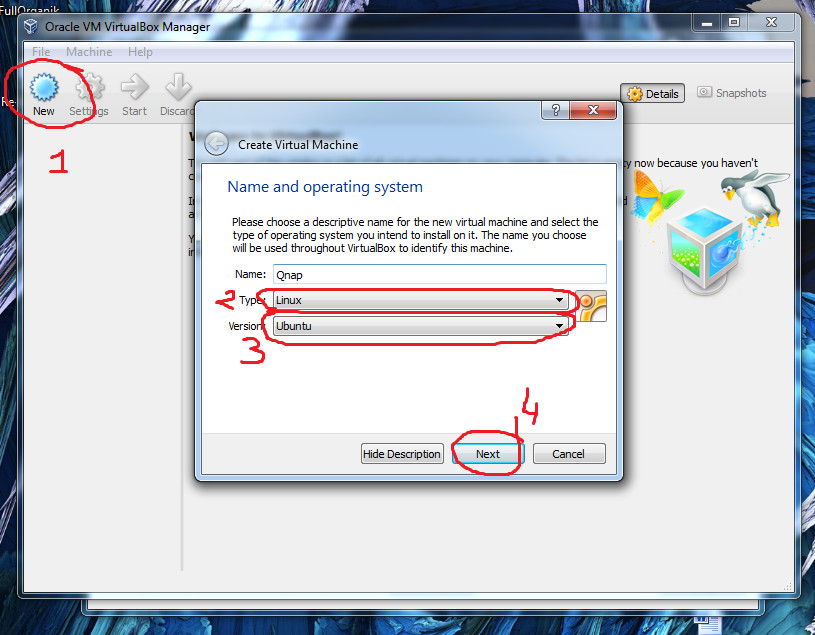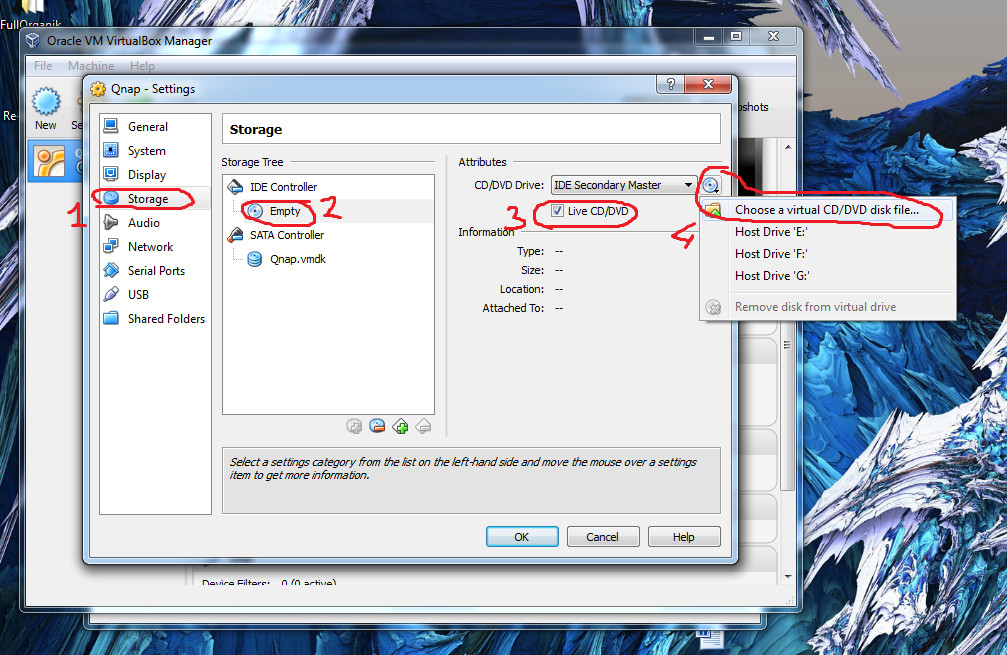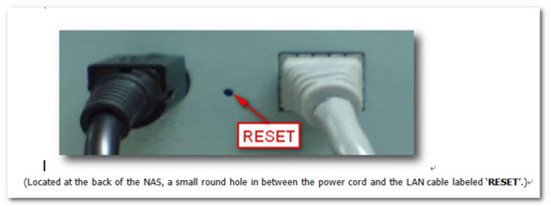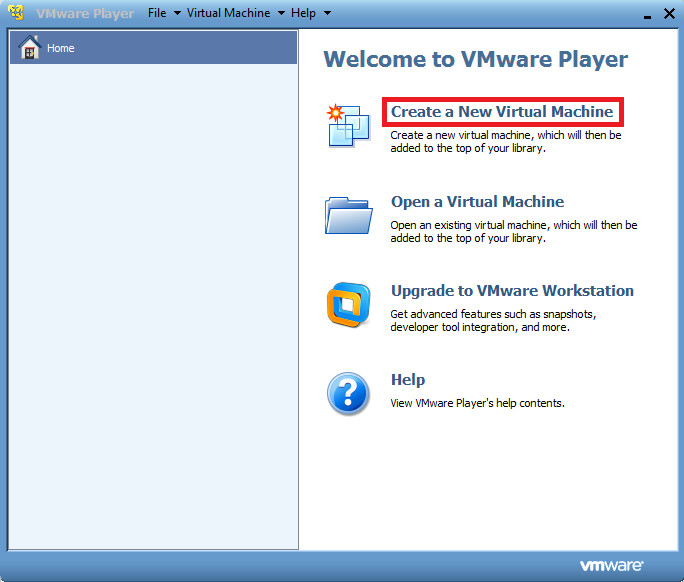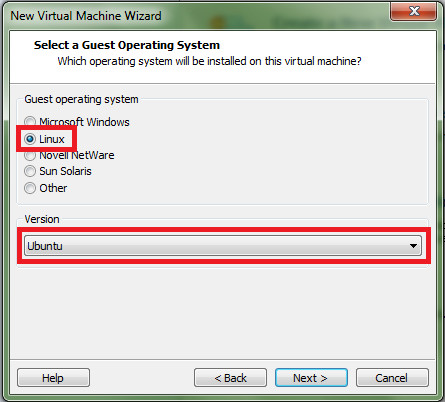Firmware Reflash for ARM Based (Ts- x10/x12/x19 Series)
I – When to use the firmware recovery guide
II – Easy Way to Firmware Reflash with VirtualBox : (Warning : this is not Official Qnap Firmware Reflash)
III – Instructions for NAS Recovery – Method 2 (Live CD)
VI – Instructions for NAS Recovery – Method 3 (VMware Player)
I – When to use the firmware recovery guide
Applied QNAP NAS models
For firmware update of QNAP TS-110, TS-112, TS-119, TS-210, TS-212, TS-219, TS-219P, TS-410, TS-410U, TS-412, TS-412U, TS-419P, TS-419U, TS-419U+, TS-119P+, TS-219P+, TS-419P+ Turbo NAS servers via recovery mode.
When to use the firmware recovery guide
This firmware recovery guide is intended for users who encounter system startup failure due to incomplete or unsuccessful firmware update caused by power outage or network disconnection during the process. To verify if this guide applies to your NAS, follow the steps below:
- Power off the NAS.
- Remove all the hard disks.
- Power on the NAS.
- Wait for ten seconds and check if you hear a short beep.
- After the short beep, wait for two minutes to check if you hear a long beep.
- If you only hear a short beep or do not hear any beep, follow the instructions of this guide to recover your NAS.
II – Easy Way to Firmware Reflash with VirtualBox : (Warning : this is not Official Qnap Firmware Reflash)
1 – Download the live CD ISO image from the following links
Note: Please use the ISO file (a) for 1-bay and 2-bay NAS models (TS-110/210/119/219/219P). If you failed to recover the NAS with the file (a), please try to use the ISO file (b).
a. TS-110, TS-119, TS-210, TS-219, TS-219P
b. TS-410, TS-410U, TS-419, TS-419U
c. TS-x119P+, TS-219P+, or TS-419P+
d. TS-112/212/412/412U/419U/419U+
2 – Download and install Virtual Box;
https://www.virtualbox.org/wiki/Downloads
3 – Setup Vrtualbox:
Step 1 :Start software and Choose “New”;
Type : Linux,
Version: Ubuntu
Step 2 : Memory size : 512 mb
Step 3 : choose “Create a Virtual Drive Now”
Step 4 : Choose VDI -> Dynamical allocated
4 – right click to your virtual server -> Settings ->storage.
controller : IDE -> CD/DVD Drive -> Choose a virtual DC /DVD and choose your device firmware
5 – go to Network -> Adapter 1 –and choose Bridge Adapter.
6 – Also be sure that you choose right Ethernet port. (you may have different Lan port if VMWare is install on your computer.)
7 – Start your virtual server
8 – Choose first option:
When the login prompt is shown, go to next step. No login is required:
9 – Power off the NAS and remove all hard disks.
10 – Connect the NAS to the PC directly by an Ethernet cable. If your NAS includes two LAN ports, please connect LAN 2 of the NAS to the PC. If it doesn’t work try it again with LAN 1
11. Find the RESET button of the NAS (see below).
12. Use a pen or any pointed object to press and hold the RESET button. Then press the Power button on the front panel to power on the NAS at the meanwhile.
13. Please keep holding the RESET button around 25 seconds.
14. The LED on the LAN port of the NAS should be flashing for the first few seconds and then glows green or orange.
15. LEAVE THE NAS ALONE AT THIS POINT! DO NOT TURN IT OFF OR UNPLUG THE POWER CORD. Wait for about 5 minutes.
Note: To make sure if the data has been delvering to NAS or not, you can login to the console by the username and password, root/root. Then, use the command “ifconfig” to see if the number of TX on eth0 is increasing or not.
16. Wait until you hear a long beep or two short beeps and see the Status LED flashing green. The NAS will then reboot. No intervention required during this stage.
17. The reboot should take about 3 minutes. After that you should hear a long beep.
18. Connect the NAS to your switch or router and use QNAP Finder to find the NAS.
19. Power off the NAS, plug the HDD(s) back by original order, then power it on.
20. Download the latest firmware from QNAP website(http://www.qnap.com/download.asp), unzip the file, and perform firmware upgrade through QNAP Finder.
21. On QNAP Finder, select the NAS, click Tools -> Update Firmware to update the NAS firmware.
III – Instructions for NAS Recovery – Method 2 (Live CD)
Follow the steps below to recover the NAS.
1. Download the live CD ISO image from the following links and “BURN” it into an empty CD-R.
Note: Please use the ISO file (a) for 1-bay and 2-bay NAS models (TS-110/210/119/219/219P). If you failed to recover the NAS with the file (a), please try to use the ISO file (b).
a. TS-110, TS-119, TS-210, TS-219, TS-219P
b. TS-410, TS-410U, TS-419, TS-419U
c. TS-x119P+, TS-219P+, or TS-419P+
d. TS-112/212/412/412U/419U/419U+
2. Burn the ISO file to a CD.
3. Insert the CD to a PC and boot up from the CD.
4. When the login prompt is shown, go to next step. No login is required. 5. Power off the NAS and remove all hard disks.
6. Connect the NAS to the PC directly by an Ethernet cable. If your NAS includes two LAN ports, please connect LAN 2 of the NAS to the PC. If it doesn’t work try it again with LAN 1
7. Find the RESET button of the NAS (see below).
8. Use a pen or any pointed object to press and hold the RESET button. Then press the Power button on the front panel to power on the NAS at the meanwhile.
9. Please keep holding the RESET button and Power button until you hear two short beeps in about 5-8 seconds. The Status LED of the NAS should be flashing red and green and then glows red.
10. The LED on the LAN port of the NAS should be flashing for the first few seconds and then glows green or orange.
11. LEAVE THE NAS ALONE AT THIS POINT! DO NOT TURN IT OFF OR UNPLUG THE POWER CORD. Wait for about 5 minutes.
Note: To make sure if the data has been delvering to NAS or not, you can login to the console by the username and password, root/root. Then, use the command “ifconfig” to see if the number of TX on eth0 is increasing or not.
12. Wait until you hear a long beep or two short beeps and see the Status LED flashing green. The NAS will then reboot. No intervention required during this stage.
13. The reboot should take about 3 minutes. After that you should hear a long beep.
14. Connect the NAS to your switch or router and use QNAP Finder to find the NAS.
15. Power off the NAS, plug the HDD(s) back by original order, then power it on.
16. Download the latest firmware from QNAP website(http://www.qnap.com/download.asp), unzip the file, and perform firmware upgrade through QNAP Finder.
17. On QNAP Finder, select the NAS, click Tools -> Update Firmware to update the NAS firmware.
How to do if the startup problem persists
If the startup problem persists, please return the NAS to your local dealer or distributor for system repair immediately.
NOTE: If the recover progress does not work at the first time, please try another PC or reburn the ISO image.
VI – Instructions for NAS Recovery – Method 3 (VMware Player)
Follow the steps below to recover the NAS.
Note: Please use the ISO file (a) for 1-bay and 2-bay NAS models (TS-110/210/119/219/219P). If you failed to recover the NAS with the file (a), please try to use the ISO file (b).
a. TS-110, TS-119, TS-210, TS-219, TS-219P
b. TS-410, TS-410U, TS-419, TS-419U
c. TS-x119P+, TS-219P+, or TS-419P+
d. TS-112/212/412/412U/419U/419U+
2. Download and install VMware Player:
http://www.vmware.com/go/downloadplayer/
3. Disconnect any wireless network connections on your PC
4. Run VMware Player, and click on “Create a New Virtual Machine”
5. Select “Installer disc image file (iso)”, and choose the ISO file downloaded in Step 1. Click “Next”
6. Select “Linux” and “Ubuntu”, click “Next”
7. For virtual machine name and disk settings, click “Next”.
8. Click “Customize Hardware”
9. Under “Network Adapter”, select Network Connection as “Bridged”, then click “Close”
10. Click “Finish”. The virtual machine will start booting in a window. (If you get a message about software updates, click “Remind Me Later”)
11. When the login prompt is shown, go to next step. No login is required.
12. Power off the NAS and remove all hard disks.
13. Connect the NAS to the PC directly by an Ethernet cable. If your NAS includes two LAN ports, please connect LAN 2 of the NAS to the PC. If it doesn’t work try it again with LAN 1
14. Find the RESET button of the NAS (see below).
15. Use a pen or any pointed object to press and hold the RESET button. Then press the Power button on the front panel to power on the NAS at the meanwhile.
16. Please keep holding the RESET button and Power button until you hear two short beeps in about 5-8 seconds. The Status LED of the NAS should be flashing red and green and then glows red.
17. The LED on the LAN port of the NAS should be flashing for the first few seconds and then glows green or orange.
18. LEAVE THE NAS ALONE AT THIS POINT! DO NOT TURN IT OFF OR UNPLUG THE POWER CORD. Wait for about 5 minutes.
Note: To make sure if the data has been delivering to NAS or not, you can login to the console by the username and password, root/root. Then, use the command “ifconfig” to see if the number of TX on ETH0 is increasing or not.
19. Wait until you hear a long beep or two short beeps and see the Status LED flashing green. The NAS will then reboot. No intervention required during this stage.
20. The reboot should take about 3 minutes. After that you should hear a long beep.
21. Connect the NAS to your switch or router and use QNAP Finder to find the NAS.
22. Power off the NAS, plug the HDD(s) back by original order, then power it on.
23. Download the latest firmware from QNAP website(http://www.qnap.com/download.asp), unzip the file, and perform firmware upgrade through QNAP Finder.
24. On QNAP Finder, select the NAS, click Tools -> Update Firmware to update the NAS firmware.
What to do if the startup problem persists
If the startup problem persists, please return the NAS to your local dealer or distributor for system repair immediately.
NOTE: If the recover progress does not work at the first time, please try another PC and make sure all other network connections are disabled.

